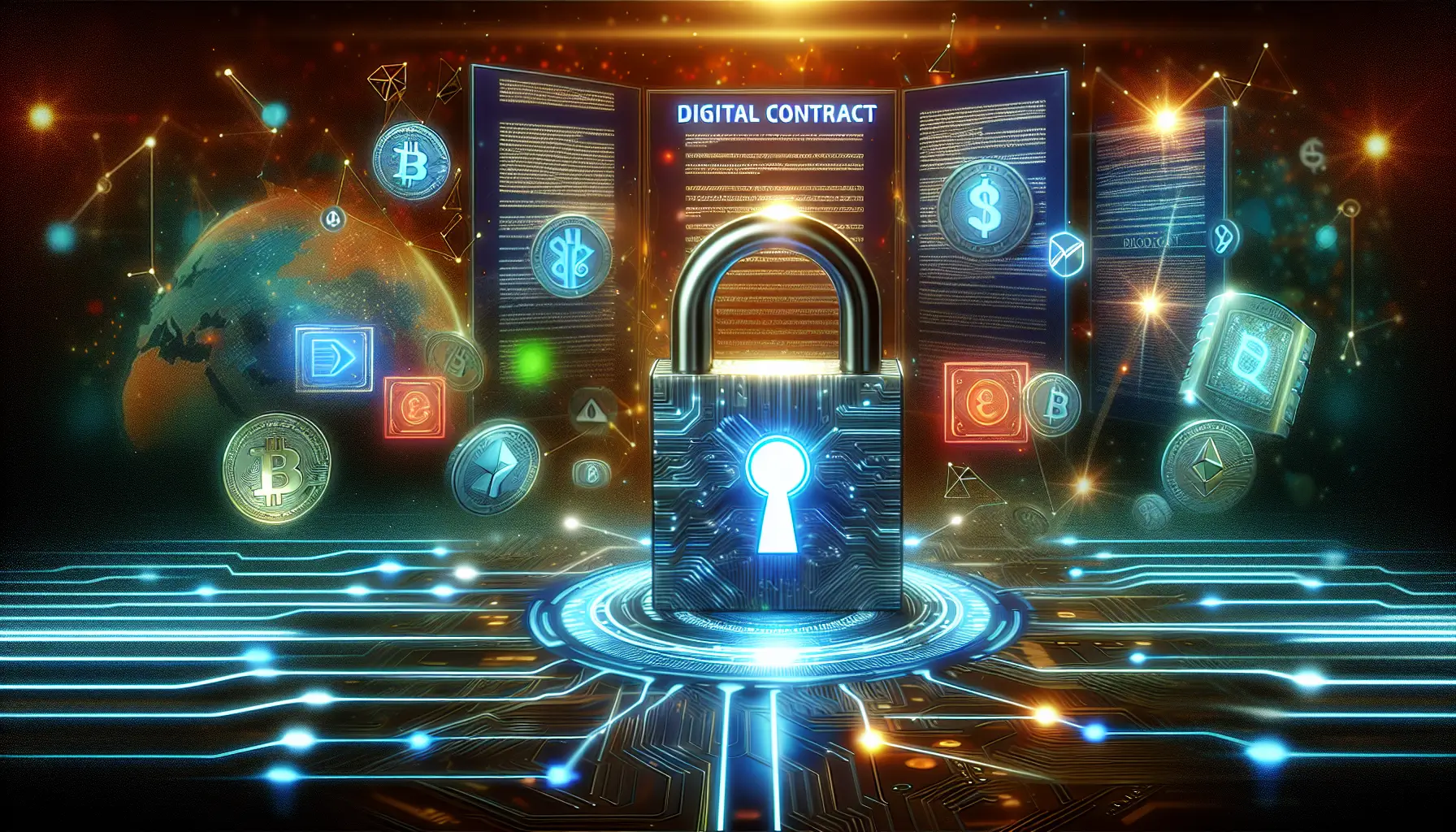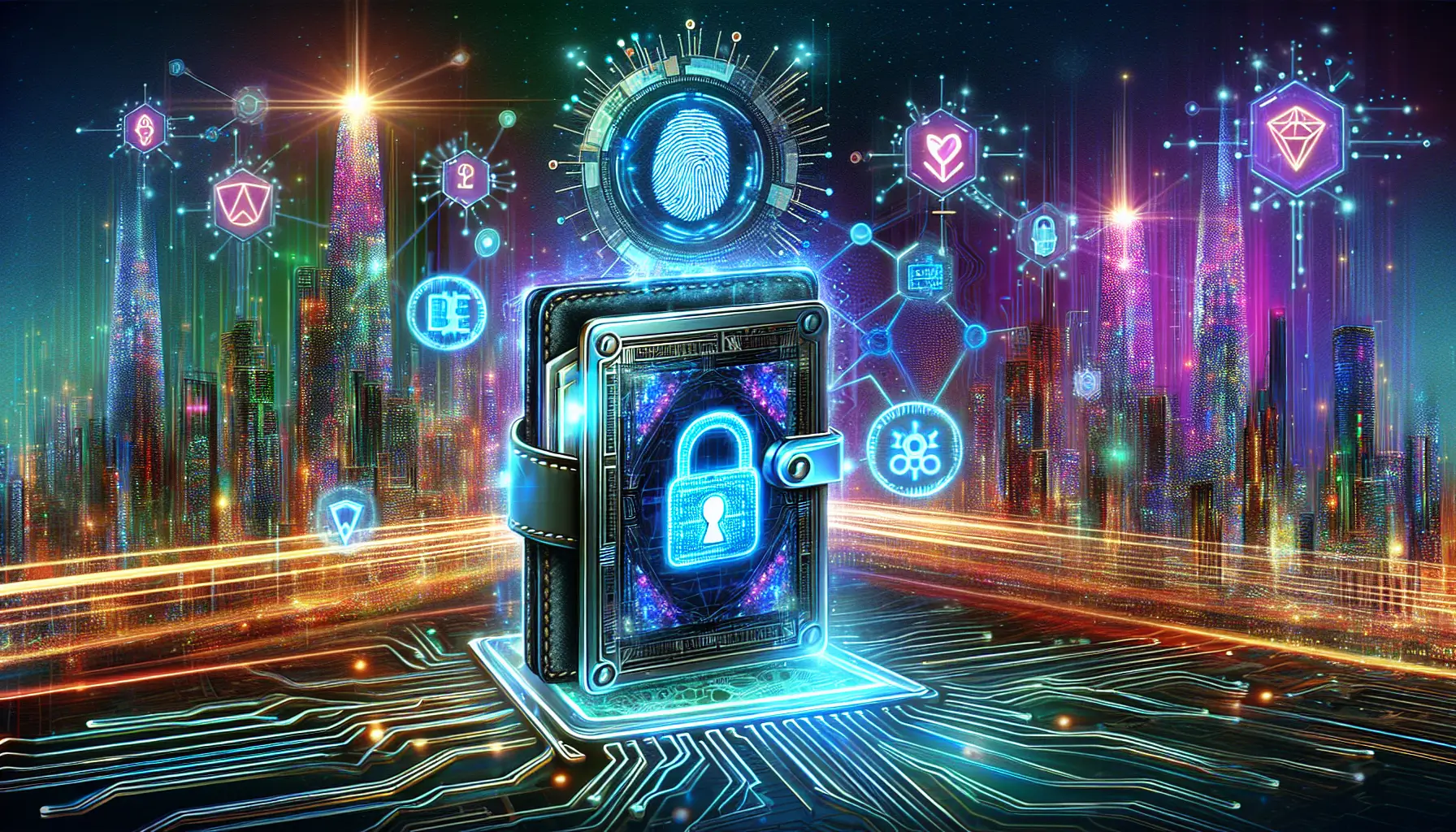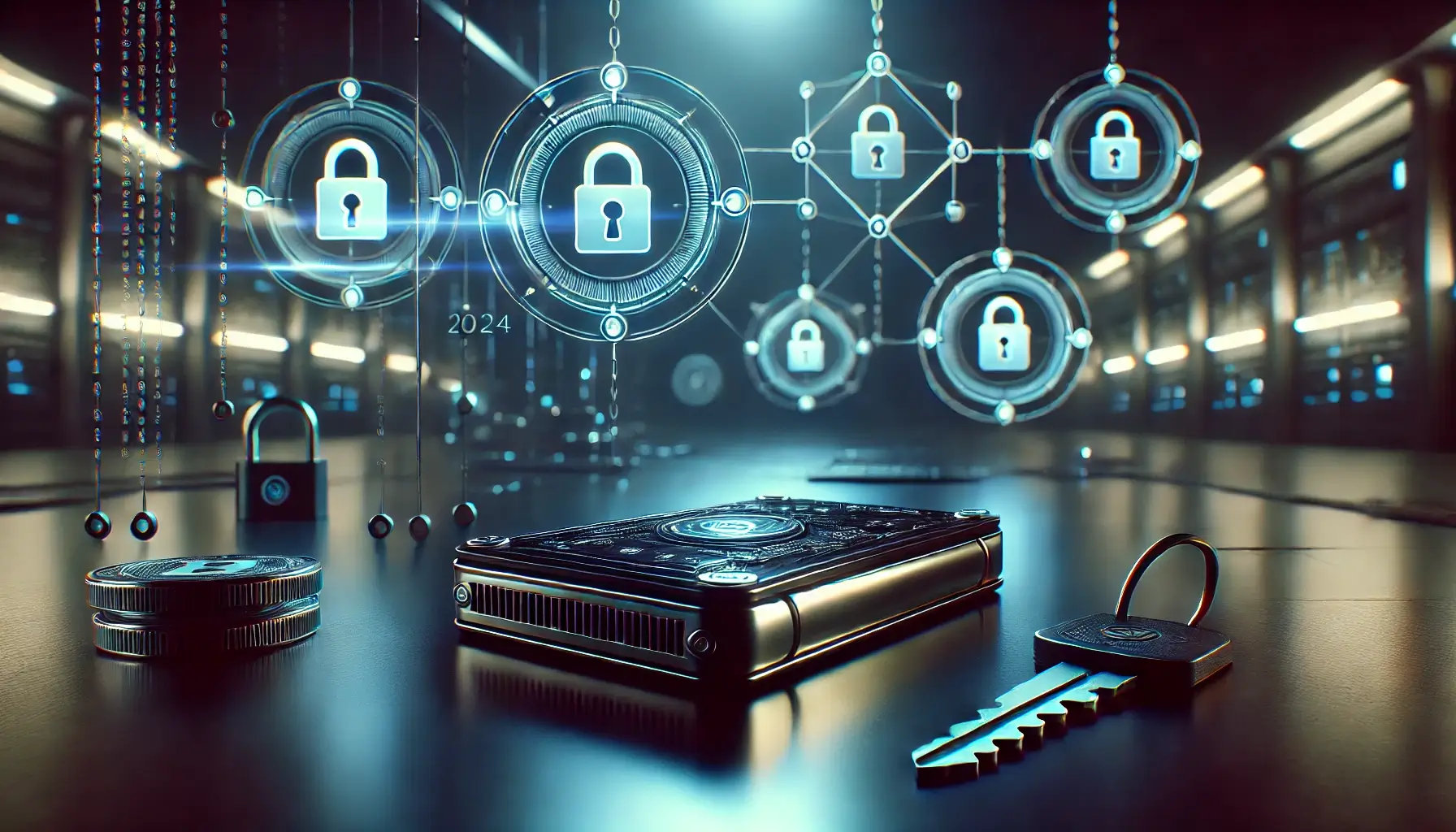In 2024, crypto wallets and security: what has changed in 2024 has seen major advancements. Enhanced encryption techniques, multi-factor and biometric authentication, and AI integration are now standard features. This article will delve into these innovations, their impacts on security, and the new trends shaping the future of crypto wallets.
Key Takeaways
- Crypto wallets in 2024 have advanced with AI integration, enhancing security and user experience by identifying threats in real-time and supporting a wider variety of cryptocurrencies.
- Enhanced security measures, including advanced encryption, multi-factor authentication, and biometric authentication, significantly protect digital assets against cyber threats and unauthorized access.
- Regulatory changes worldwide enforce higher security standards for crypto wallets, necessitating regular audits and compliance checks to bolster user trust and market integrity.
| Category | 2023 | 2024 Changes | Impact |
|---|---|---|---|
| Security Enhancements | Basic 2FA and hardware wallets were standard | Introduction of multi-signature biometric wallets | Increased security and protection against phishing attacks |
| Regulatory Compliance | Limited global standards | New international standards for wallet providers | Enhanced trust and adoption among institutional investors |
| User Experience | Complexity in managing multiple wallets | Unified wallet interfaces with AI-driven management | Simplified user experience and broader adoption |
| Backup & Recovery | Seed phrases stored offline | Shamir’s Secret Sharing integrated for easy recovery | Reduced risk of loss due to forgotten seed phrases |
| Cross-Chain Compatibility | Mostly single-chain wallets | Cross-chain compatibility as a standard feature | Seamless transactions across different blockchains |
| Decentralized Identity (DID) | Early-stage development | Full integration with wallets for secure authentication | Enhanced privacy and security for users |
| Quantum Resistance | Limited awareness and preparation | Implementation of quantum-resistant cryptography | Future-proofing against potential quantum threats |
| Interoperability | Limited, often requiring separate apps or tools | Increased interoperability between DeFi platforms | More seamless user experience and integration with DeFi |
| Hot Wallet Innovations | Vulnerable to malware and online attacks | Enhanced hot wallet security with real-time monitoring and AI-based threat detection | Reduced risk of hot wallet compromises |
| Cold Storage Evolution | Hardware wallets with physical connections | Air-gapped cold storage solutions with biometric access | Maximum security for large holdings |
This table highlights the key advancements in crypto wallets and security in 2024, reflecting how these changes impact users and the broader cryptocurrency ecosystem.
The Evolution of Crypto Wallets in 2024

The evolution of crypto wallets in 2024 has been nothing short of revolutionary. Integrating artificial intelligence (AI) to enhance user experience and security is one of the most significant advancements.
AI-powered wallets can now identify and mitigate potential threats in real-time, making crypto transactions safer and more efficient. Additionally, these wallets have become more inclusive, supporting a broader range of cryptocurrencies, reflecting the growing diversity in the crypto market.
At their core, crypto wallets are digital software designed to store and manage cryptocurrencies, offering users control over their digital assets. A primary advantage of private wallets over exchange-held assets is their enhanced security.
With private wallets, users retain control over their private keys, significantly reducing the risk of hacks and unauthorized access to crypto prices compared to custodial wallets held by exchanges.
However, using legitimate and secure crypto exchanges, which implement robust security protocols to protect users’ digital assets against various threats in the evolving crypto landscape, is also crucial.
The increasing variety of supported cryptocurrencies is a testament to the growing and diversifying crypto space. As more digital currencies emerge, crypto wallets have adapted to accommodate these changes, ensuring users can manage their varied portfolios from a single platform.
This adaptability simplifies asset management and positions crypto wallets as central hubs for cryptocurrency activities.
Enhanced Security Measures for Crypto Wallets
With the increased adoption of cryptocurrencies, robust security measures have become paramount. Advanced security protocols were integrated into crypto wallets in 2024 to protect against various threats.
These measures include enhanced encryption techniques, multi-factor authentication (MFA), and biometric authentication, each adding layers of security to safeguard wallet data and private keys from unauthorized access.
Multi-signature wallets, which require more than one key to authorize a transaction, provide additional protection for digital assets against unauthorized access and theft.
Manufacturers of hardware wallets have also stepped up their game, incorporating tamper-proof seals and sophisticated encryption methods to safeguard software wallets against physical and cyber-attacks. These advancements ensure a secure environment for storing and transacting digital assets.
Advanced Encryption Techniques
Cryptography is the backbone of cryptocurrency wallets, playing a crucial role in authenticating transactions and generating unique hashes for wallet addresses.
Advanced encryption methods are now employed to secure cryptocurrency transactions, ensuring that digital assets are transferred safely and without risk of interception.
During a transaction, the hash transmitted includes the amount being transferred, the receiver’s address, and a signature from the sender’s private key, maintaining the integrity and security of the transaction.
Advanced encryption techniques represent one of the most significant steps in enhancing digital security. These methods protect the transactions and the private keys integral to accessing and controlling the assets within the wallet.
Robust security measures in crypto wallets ensure that intercepted data cannot be deciphered without the appropriate cryptographic keys.
In addition to securing transactions, these encryption techniques help mitigate cyber attacks. As the sophistication of cyber threats grows, the need for equally advanced security protocols becomes evident.
Updating and improving these encryption methods keeps crypto wallets ahead of potential threats, ensuring user assets remain secure.
Multi-Factor Authentication (MFA)
Multi-factor authentication (MFA) has become a cornerstone of enhanced security for crypto wallets. MFA, which requires users to provide two or more verification factors, significantly reduces the risk of unauthorized access.
This additional layer of protection goes beyond just passwords, adding a two factor authentication is crucial defense mechanism against potential breaches.
Implementing MFA involves generating temporary codes for login, which users must enter alongside their passwords. This process ensures the attacker still needs the secondary factor to gain access, even if a password is compromised.
The enhanced security provided by MFA makes it a vital feature for safeguarding digital assets and maintaining the integrity of cryptocurrency wallets.
Biometric Authentication
Biometric authentication introduces a new level of security by leveraging unique physical traits for access. This method is particularly effective for mobile wallets, where advanced features like fingerprint scanning, facial recognition, and even advanced techniques such as voice recognition and vein pattern identification are becoming standard.
Employing biometric methods significantly strengthens the security of mobile wallets, making unauthorized access exceedingly difficult. As biometric technology evolves, these methods provide a robust and user-friendly way to protect digital assets, ensuring that only the rightful owner can access their crypto accounts.
| Security Measure | Description | Advantages | Challenges |
|---|---|---|---|
| Multi-Signature (Multi-Sig) | Requires multiple private keys to authorize a transaction. | Increases security by reducing the risk of a single point of failure. | It requires coordination and can be complex for non-technical users. |
| Hardware Wallets | Physical devices that store private keys offline. | Protects against online hacking attempts and malware. | It can be lost, damaged, or stolen; users need to back up recovery phrases. |
| Cold Storage | Storing private keys on a device that is not connected to the internet. | Strong protection against online threats. | It is not convenient for frequent transactions; there is a risk of physical damage or loss. |
| Two-factor authentication (2FA) | It adds an extra layer of security by requiring a second form of identification. | Provides an additional barrier to unauthorized access. | Can be compromised through phishing or SIM-swapping attacks. |
| Biometric Authentication | Uses fingerprints, facial recognition, or other biometric data for access. | Convenient and difficult to replicate, offering strong protection. | Privacy concerns are not foolproof (e.g., potential for false positives). |
| Allow listing Addresses | Allows transactions only to pre-approved wallet addresses. | Reduces the risk of sending funds to malicious or unintended addresses. | Inconvenient if frequently sending to new addresses; needs careful setup. |
| Decentralized Identity (DID) | Uses blockchain-based identity systems to enhance wallet security. | Enhances privacy and security by decentralizing identity management. | Still, in the early stages, broad adoption is required to be effective. |
| Seed Phrase Backups | A series of words used to recover access to a wallet. | It is essential for recovering wallets if access is lost. | Must be stored securely; wallet access cannot be recovered if lost. |
| Encryption of Private Keys | Encrypting the private keys adds an extra layer of protection. | Protects against unauthorized access even if the device is compromised. | It requires secure password management, which is complex for some users. |
| Regular Software Updates | Ensures wallet software is up-to-date with the latest security patches. | Protects against known vulnerabilities and exploits. | Users must stay informed and apply updates promptly. |
| Use of Trusted Wallet Providers | Choosing wallet software and services from reputable providers. | Reduces the risk of using compromised or insecure software. | Sophisticated attacks might still target trusted providers. |
This table provides an overview of the key security measures available to enhance the safety of crypto wallets, including their benefits and potential challenges.
New Trends in Hardware Wallets
Hardware wallets have seen substantial innovations in 2024, addressing security and user experience. These devices, which store a keystore file for crypto transactions, are now designed to be more aesthetically pleasing and compact, making them secure but also user-friendly and portable.
A hardware wallet enhances the security of your digital and stored crypto assets.
The latest hardware wallets also support various cryptocurrencies, accommodating the expanding crypto market. This versatility ensures that users can manage multiple digital assets securely from one mobile device, enhancing the overall user experience.
Improved User Interfaces
The user interfaces of hardware wallets have undergone significant improvements, making them more accessible to non-technical users. Enhanced interfaces prioritize simplicity and ease of use, enabling users to manage their digital assets with minimal hassle.
Modern hardware wallets now feature touchscreens and customizable interfaces, providing an intuitive user experience that the user-friendly interface caters to a broad range of users.
These advancements are not just about aesthetics; they are designed to improve the global accessibility of online wallets.
User-friendly interfaces make hardware wallets more widely adopted, enabling more people to secure their digital assets effectively.
Increased Storage Capabilities
Another significant trend in hardware wallets is the increased storage capabilities of mobile devices. Modern hardware wallets can now support storing over 5,000 different cryptocurrencies, allowing users to manage a diverse portfolio of assets in one device securely.
This advancement not only enhances user experience but also ensures efficient asset management. By supporting a broader range of cryptocurrencies, hardware wallets cater to the needs of a growing and diversifying crypto market, offering greater security and convenience for offline wallet use.
| Trend | Description | Key Examples | Impact |
|---|---|---|---|
| Multi-Signature Support | Allows multiple parties to approve a transaction, increasing security. | Coldcard, Ledger Nano X | Enhances security by requiring multiple approvals for transactions. |
| Biometric Authentication | Integration of biometric security (e.g., fingerprint, facial recognition). | Ledger Stax, SecuX V20 | It adds an extra layer of security and convenience. |
| Bluetooth Connectivity | Wireless connectivity for easier access to mobile devices. | Ledger Nano X, Trezor Model T | Facilitates on-the-go transactions, improving user experience. |
| Air-Gapped Devices | Completely isolated devices that do not connect to the internet or other devices. | Coldcard MK4, Ellipal Titan | It provides maximum security by preventing any online attack vector. |
| NFT Support | Allows users to store and manage non-fungible tokens (NFTs) securely. | Ledger Nano X, Trezor Model T | Expands the functionality of hardware wallets to support digital collectibles. |
| QR Code Transactions | QR codes can be used to facilitate transactions without requiring a physical connection. | Ellipal Titan, Keystone Pro | Enhances security by minimizing physical connections and potential attacks. |
| E-Ink Displays | Integration of e-ink screens for low-power, high-contrast display of information. | Ledger Stax, Keystone Essential | Improves readability and battery efficiency, especially for prolonged use. |
| Open-Source Firmware | Allows the community to audit and contribute to the wallet’s security features. | Trezor Model T, Foundation Passport | Increases trust and transparency, enabling thorough security audits. |
| Modular Design | Customizable wallets with interchangeable components or accessories. | GridPlus Lattice1, Coldcard MK4 | It provides flexibility and allows users to tailor the wallet to their needs. |
| Advanced Passphrase Management | Enhanced options for managing and recovering passphrases. | Ledger Nano X, Trezor Model T | Improves security and user experience by offering more secure passphrase recovery. |
| Mobile Integration | Seamless integration with mobile apps for real-time monitoring and management. | Ledger Nano X, SecuX W20 | Offers convenience and ease of access, particularly for frequent transactions. |
| Privacy-Focused Features | Features that enhance privacy, such as Tor support or coin mixing. | Coldcard MK4, BitBox02 | Protects user anonymity and transaction privacy. |
| DeFi Integration | Compatibility with decentralized finance (DeFi) platforms. | Ledger Nano X, Trezor Model T | Enables direct interaction with DeFi platforms, expanding wallet utility. |
| Durable and Tamper-Proof Designs | Use of high-quality, tamper-resistant materials and build quality. | Ellipal Titan, Coldcard MK4 | Ensures long-lasting durability and protection against physical tampering. |
This table highlights the ongoing innovations and emerging trends in hardware wallets, emphasizing how they enhance cryptocurrency users’ security, usability, and functionality.
Regulatory Changes Impacting Wallet Security

Regulatory changes in 2024 have had a profound impact on wallet security. Countries like Japan, South Korea, and Brazil have introduced stringent regulations to enhance transparency, record-keeping, and fraud prevention.
These regulations necessitate regular security audits and compliance checks, ensuring crypto wallets adhere to high-security standards.
In the EU, the Markets in Crypto-Assets Regulation (MiCA) imposes comprehensive licensing requirements, affecting how wallets operate and mandating identity verification for transactions over 1,000 euros starting January 2026.
Designed to protect users and uphold the integrity of the crypto market, these regulatory measures make security a top priority for wallet providers.
| Regulatory Area | Description | Impact on Wallet Security | Examples |
|---|---|---|---|
| KYC/AML Compliance | Regulations requiring Know Your Customer (KYC) and Anti-Money Laundering (AML) measures. | Enhanced identity verification, leading to more secure wallets but reduced anonymity. | European Union’s AMLD5, U.S. FinCEN guidelines |
| Data Privacy Regulations | Laws focused on protecting user data and privacy. | Stricter data handling practices, reducing the risk of data breaches affecting wallet security. | GDPR (Europe), CCPA (California) |
| Crypto Custody Rules | Regulations govern how custodians manage and secure digital assets. | More stringent requirements for secure storage lead to safer custodial wallets. | SEC’s Custody Rule, European Commission’s MiCA |
| Cybersecurity Standards | Guidelines and mandates for maintaining robust cybersecurity practices in financial services. | Increased emphasis on encryption and secure storage practices. | NIST Cybersecurity Framework, ISO 27001 |
| Legal Liability Reforms | Changes in laws holding wallet providers accountable for security breaches. | Greater focus on implementing advanced security measures to avoid penalties. | U.S. Cybersecurity Improvement Act, EU’s eIDAS Regulation |
| Tax Reporting Requirements | Rules requiring accurate reporting of crypto transactions for tax purposes. | Necessitates secure transaction records within wallets to comply with reporting standards. | U.S. IRS Notice 2014-21, OECD’s Crypto-Asset Reporting Framework |
| Cross-Border Regulations | International rules governing cross-border crypto transactions and asset storage. | Potential for fragmented security standards, leading to varied wallet security protocols across regions. | FATF Travel Rule, EU’s DAC7 |
This table concisely overviews key regulatory areas affecting wallet security, detailing their descriptions, specific impacts on wallet security, and examples of relevant regulations.
Protecting Against New Security Threats

Protecting against new threats is crucial in the ever-evolving landscape of digital security. Users must proactively secure their digital assets, including protecting private keys and networks. Staying vigilant and adopting robust security measures is crucial as sophisticated attacks rise.
The subsections below will delve into specific threats, such as phishing attempts and malware, providing insights on safeguarding against these security risks.
Phishing Attempts
Phishing remains one of the most prevalent methods of attack in the digital world. Phishing attempts in 2024 have resulted in significant financial losses, emphasizing the need for users to stay vigilant against fraudulent communications. These attacks often involve deceptive emails and websites that trick users into revealing their private keys or other sensitive information.
To protect against phishing, users should verify the authenticity of communications and avoid clicking on suspicious links.
By being cautious and employing security measures like MFA, users can reduce the risk of falling victim to phishing attempts and protect their digital assets from unauthorized access.
Malware and Ransomware
Malware and ransomware are significant threats to crypto security. Attackers often use these malicious programs to access users’ private keys and sensitive information. A strong password and secure network practices can help mitigate these risks.
Users should be cautious when downloading files from untrusted sources and regularly update their security software to protect against malware. By staying informed and vigilant, users can safeguard their cryptocurrency wallets from these pervasive threats.
| Category | Description | Examples of Emerging Threats | Protective Measures |
|---|---|---|---|
| Cybersecurity Threats | Threats from cybercriminals exploiting software vulnerabilities and weaknesses. | Zero-day exploits, ransomware attacks, phishing schemes | Regular software updates, multi-factor authentication, advanced threat detection systems |
| Physical Security Threats | Threats that involve direct physical access to sensitive equipment or facilities. | Theft of hardware, unauthorized access to data centers | Biometric security systems, access control protocols, surveillance systems |
| IoT and Smart Devices Threats | Vulnerabilities in interconnected devices that are often less secure than traditional IT systems. | Botnet attacks, data breaches via smart home devices | Segmentation of networks, regular firmware updates, strong device passwords |
| Social Engineering Threats | Manipulative tactics to trick individuals into compromising security. | Spear phishing, vishing (voice phishing), impersonation scams | Security awareness training, robust identity verification processes |
| Cloud Security Threats | Threats targeting data stored in or processed through cloud services. | Misconfiguration, data leaks, account hijacking | Encryption, access management, continuous monitoring of cloud environments |
| Supply Chain Threats | Threats arising from supply chain vulnerabilities impact software or hardware integrity. | Supply chain attacks, counterfeit components | Vendor assessment, supply chain audits, use of trusted suppliers |
| AI and Machine Learning Threats | AI and ML models are exploited for malicious purposes or to bypass security systems. | Adversarial attacks on ML models, deep fake scams | Robust model validation, adversarial training, AI system monitoring |
| Cryptocurrency Security Threats | Emerging threats targeting crypto assets and blockchain technology. | Cryptojacking, wallet theft, exchange hacks | Cold storage for crypto, decentralized security protocols, advanced encryption methods |
| Quantum Computing Threats | Potential future threats as quantum computing could break current encryption standards. | Breaking of RSA encryption, a threat to blockchain security | Development of quantum-resistant algorithms, quantum key distribution |
| Insider Threats | Security threats originate from within an organization, often involving employees or contractors. | Data theft, sabotage, espionage | Insider threat detection programs, employee monitoring, strict access controls |
| Biometric Security Threats | Emerging threats targeting biometric systems, such as fingerprint or facial recognition technologies. | Biometric spoofing, database breaches with biometric data | Liveness detection, multi-factor authentication including biometrics, regular audits |
| 5G Network Security Threats | Threats exploiting the expanded attack surface introduced by 5G technology. | DDoS attacks, network slicing attacks | Network segmentation, advanced encryption techniques, constant security updates |
This table overviews various new security threats and corresponding protective measures organizations and individuals can implement to mitigate these risks.
The Role of Smart Contracts in Wallet Security

Smart contracts transform mobile wallet security by automating and enhancing various security features. These self-executing contracts, integrated with decentralized finance (DeFi) applications, utilize encryption and blockchain technology to secure private keys and transactions.
Transparency is another key advantage of smart contracts, as all transactions and codes are recorded on the blockchain, allowing for verification and reducing the risk of unauthorized access. Smart contracts enable crypto wallets to be more resilient against attacks and provide greater control over digital assets.
The Importance of Regular Security Audits
Maintaining the integrity of cryptocurrency wallets requires regular security audits. These audits help identify and mitigate vulnerabilities, preventing potential hacks and financial losses. Frequent security evaluations enable online wallet providers to detect issues early and implement necessary improvements.
Security audits also foster user trust. Knowing that their wallets undergo regular assessments gives crypto users confidence in the security measures, encouraging wider adoption of crypto wallets.
Best Practices for Storing Cryptocurrency
Storing cryptocurrency securely requires adopting best practices that enhance cryptocurrency wallet security. Using unique passwords, enabling MFA, and conducting regular security checks are fundamental steps.
The subsections below will explore specific storage methods, including hot wallets, cold wallets, and paper wallets, providing insights on choosing the right option for your needs.
Hot Wallets vs. Cold Wallets
The choice between a hot and cold wallet depends on the user’s needs for accessibility versus security. A hot wallet with the same internet connection offers quick transaction access but is more vulnerable to hacks.
On the other hand, cold wallets provide offline storage, significantly reducing the risk of online threats and making them ideal for long-term holding of assets.
Understanding the key distinctions between these types of wallets helps users make informed decisions about how to store their cryptocurrencies securely.
Paper Wallets and Offline Storage
Paper wallets are a form of offline storage where private keys and addresses are printed on paper. While they offer a high level of security against online attacks, creating paper wallets requires a secure, malware-free environment to prevent the exposure of private keys during the generation process.
Best practices for paper wallets include writing seed words on paper and storing them in a safe place. By following these precautions, paper wallet users can protect their digital assets, even offline.
| Category | Best Practices | Details |
|---|---|---|
| Hardware Wallets | Use Reputable Hardware Wallets | Purchase hardware wallets from trusted brands like Ledger, Trezor, or BitBox. Avoid buying second-hand or from unverified sources to prevent tampering or malware infection. |
| Cold Storage | Store in Cold Wallets for Long-Term | Cold wallets are offline storage methods, such as hardware or paper wallets, and are ideal for long-term storage, reducing exposure to online threats. |
| Paper Wallets | Generate and Store Securely | Generate paper wallets in a secure, offline environment. Print them using a dedicated printer and store them in a safe, fireproof, and waterproof container. |
| Multi-Signature Wallets | Enable Multi-Signature Authentication | Use multi-signature wallets that require multiple keys to authorize a transaction. This adds an extra layer of security, especially for large holdings or organizational funds. |
| Software Wallets | Use Encrypted Software Wallets | Choose software wallets with strong encryption, like Electrum or Mycelium. Regularly update the software to patch vulnerabilities and back up the wallet securely. |
| Wallet Backup | Regularly Backup Wallets | Store encrypted backups of wallet files in multiple secure locations. Use external drives and cloud storage with end-to-end encryption, and ensure backups are regularly updated. |
| Seed Phrase Management | Securely Store Seed Phrases | Write down the seed phrase in multiple secure locations (not digitally). Consider splitting the phrase and storing parts in different physical locations. Avoid storing it online or on devices. |
| Private Key Security | Keep Private Keys Offline | Private keys should never be stored online. Use hardware, paper wallets, or secure offline storage methods to keep them safe. |
| Two-Factor Authentication | Enable 2FA on All Wallets | Use two-factor authentication (2FA) on software wallets and any accounts associated with cryptocurrency holdings. Opt for hardware-based 2FA like YubiKey for added security. |
| Secure Environment | Use Secure Devices and Networks | Ensure the devices for accessing or storing cryptocurrencies are secure and malware-free. Always use secure, private internet connections (avoid public Wi-Fi). |
| Regular Audits | Conduct Security Audits | Periodically review and audit your security practices, ensuring that backups, software, and hardware are up to date and all security measures are still effective. |
| Avoid Phishing Attacks | Be Wary of Phishing | Always verify URLs, use bookmarks for wallet sites, and avoid clicking on links in emails or messages. Use email filters and security software to prevent phishing attacks. |
| Education and Awareness | Stay Informed and Educated | Continuously educate yourself on the latest security threats and best practices. Follow credible sources for updates on cryptocurrency security and adapt your practices accordingly. |
This table highlights essential practices for securely storing cryptocurrencies, ensuring that assets are protected from common threats such as hacking, phishing, and physical loss.
Future Trends in Crypto Wallet Security

Looking ahead, several future trends are set to enhance crypto wallet security. The ERC-4337 standard, for example, allows for account abstraction, improving wallet functionality and security. Quantum-resistant encryption methods are also being developed to protect against the potential threats posed by quantum computing.
Artificial intelligence and machine learning will significantly detect unusual transaction patterns and respond to threats in real-time.
These advancements and decentralized identity systems will give users more control over their personal information while enhancing transaction security.
Summary
In conclusion, the advancements in crypto wallet technology and security measures in the 2024 crypto sphere have significantly improved the safety and usability of these essential tools.
From AI integration and advanced encryption techniques to regulatory changes and new trends in hardware wallets, the crypto world is better equipped to handle the evolving threats and needs of digital asset management.
As the crypto market grows and diversifies, staying informed about these developments and adopting best practices for wallet security will be crucial. By embracing these innovations, users can confidently navigate the crypto space, knowing their assets are well-protected.
Frequently Asked Questions
What are the main advancements in crypto wallets in 2024?
In 2024, crypto wallets have made significant strides with AI integration for improved security and user experience, broader cryptocurrency support, and enhanced hardware wallet designs. These advancements aim to provide users with a more secure and versatile crypto management experience.
How do advanced encryption techniques improve wallet security?
Advanced encryption techniques enhance wallet security by generating unique hashes for wallet addresses and safeguarding private keys, which ensures data integrity during cryptocurrency transactions. This protects users from unauthorized access and enhances overall security.
What is the difference between hot wallets and cold wallets?
Hot wallets are internet-connected, allowing for easy transactions but increasing the risk of hacks, while cold wallets offer offline storage, providing enhanced security for long-term asset holding.
How do regulatory changes impact wallet security?
Regulatory changes heighten wallet security by enforcing transparency and identity verification, which improve compliance and protective standards for users. Consequently, these measures foster a more secure environment for digital assets.
What are some best practices for storing cryptocurrency securely?
To securely store cryptocurrency in crypto accounts, utilize unique passwords and enable multi-factor authentication while opting for cold wallets for enhanced security over hot wallets. Regular security audits are also essential to maintain robust protection for your assets.







